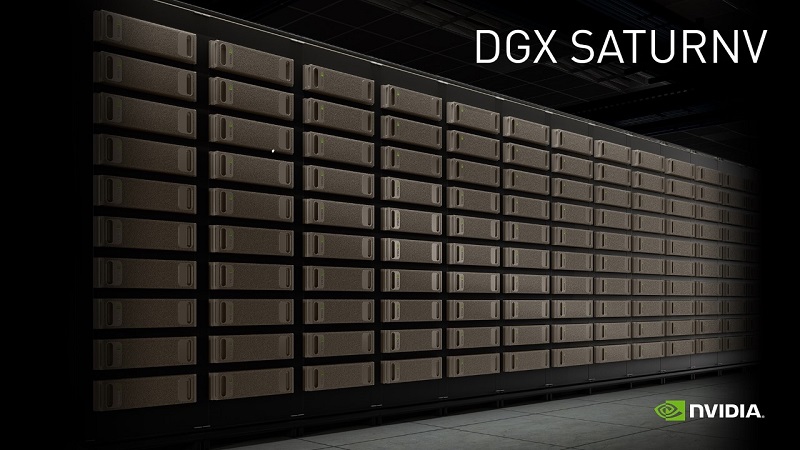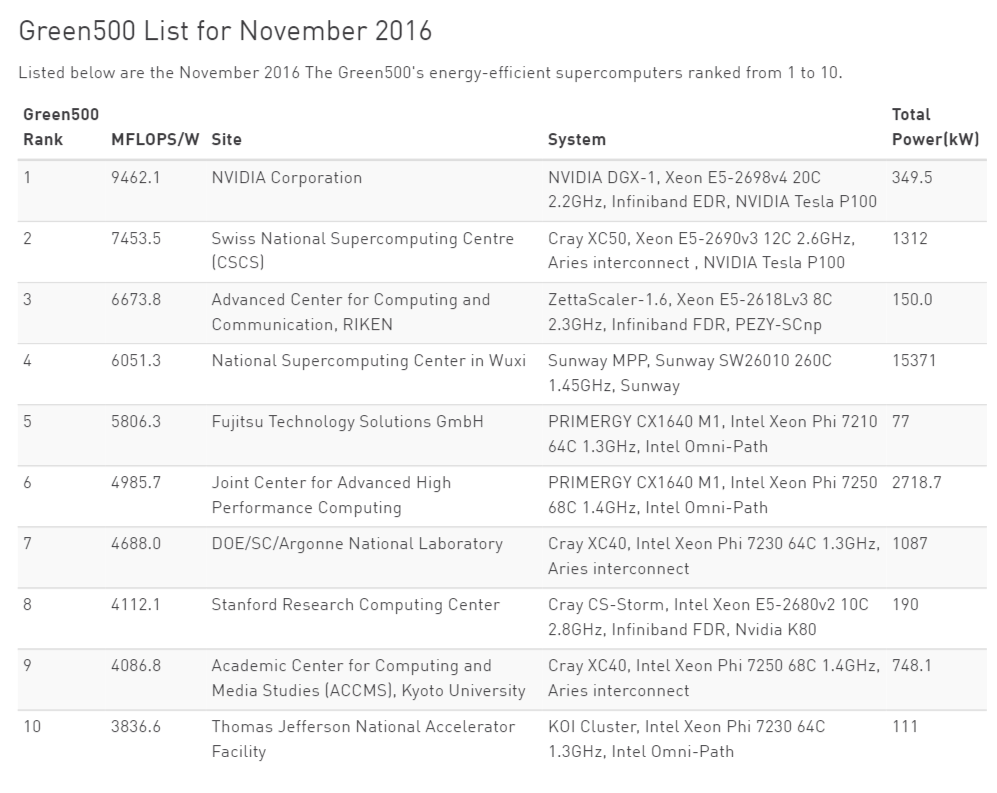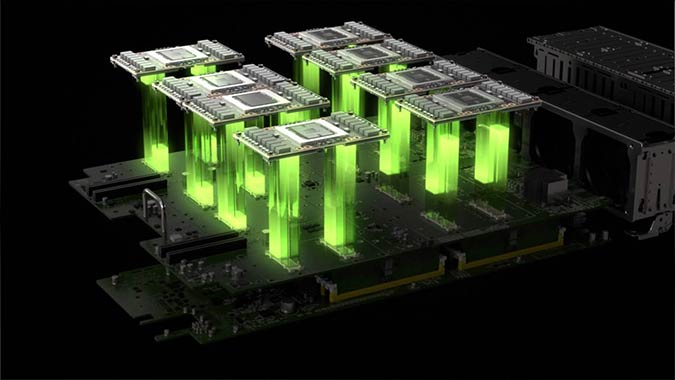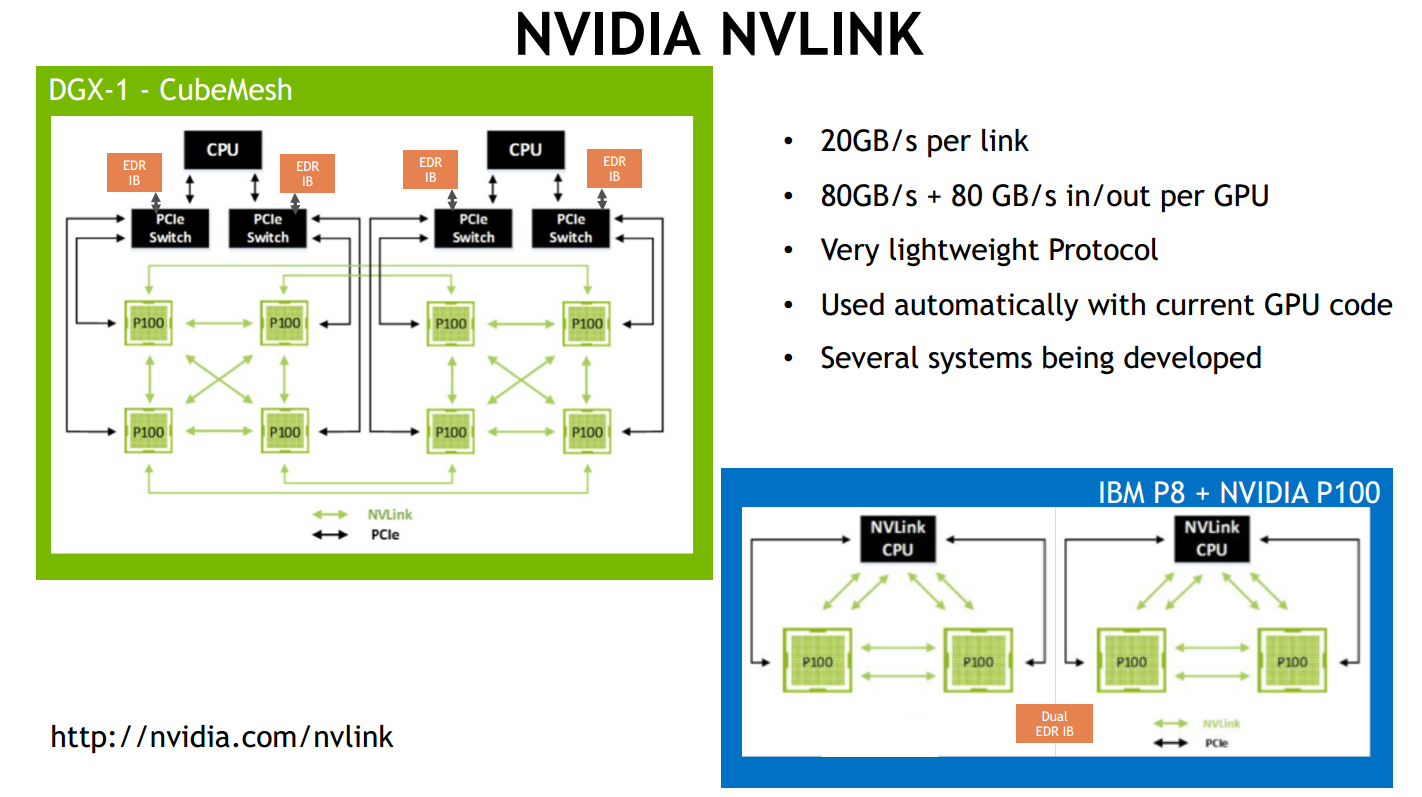Graphics chipmaker Nvidia made a strong showing at SC16 in Salt Lake City last week. Most prominent wins were achieving the number one spot on the Green500 list with new in-house DGX-1 supercomputer, SaturnV, and partnering with the National Cancer Institute, the U.S. Department of Energy (DOE) and several national laboratories to accelerate cancer research as part of the Cancer Moonshot initiative.
The company kicked off its SC activities with a press briefing on Monday (Nov. 14), during which CEO Jen-Hsun Huang characterized 2016 as a tipping point for the GPU computing approach popularized by Nvidia for over a decade.
Not surprisingly, Huang’s main message was that the GPU computing era has arrived. Throughout the hour-long talk, Huang would revisit the theme of deep learning as both a supercomputing problem and a supercomputing opportunity.
“We believe that supercomputers ought to be designed as AI supercomputers – meaning it has to be good at both computational science as well as data science – that building a machine that’s only good at data science doesn’t make sense and building a supercomputer that’s only good at computational science doesn’t make sense,” he said.
“On the one hand, deep learning requires an enormous amount of data throughput processing – this way of developing software where the computers write software themselves inspired by a lot of data processing behind it is a very important approach to computing but it also has the wonderful opportunity to benefit supercomputing as well, solving problems for science that hasn’t been possible before today,” said Huang.
Huang’s view is that traditional numerical HPC is not going anywhere, but will exist side by side with machine learning methods.
“I’m a big fan of using math when you can; we should use AI when you can’t,” he said. “For example what’s the equation of a cat? It’s probably very similar to the equation for a dog – two ears, four legs, a tail. And so there are a lot of areas where equations don’t work and that’s where I see AI – search problems, recommendation problems, likelihood problems, where there’s either too much data, incomplete data, or no laws of physics that support it. So where do I feel like eating tonight – there’s no laws of physics for that. There’s a lot of these type of problems that we simply can’t solve – I think that they’re going to coexist.”
While Nvidia is enabling parallel computing via thousands of CUDA cores combined with the CUDA programing framework, the CEO emphasized the necessity of a performant central processing unit. “Almost everything we do we start with a strong CPU,” said Huang. “We still believe in Amdahl’s law; we believe that code has a lot of single threaded parts to it and this is an area that we want to continue to be good at.”
The two servers currently shipping with the NVLink P100 GPU – Nvidia’s DGX-1 server and IBM’s Minsky platform – speak to this goal. The DGX-1 connects eight NVLink’d Pascal P100s to two 20-core Intel Xeon E5-2698 v4 chips. The IBM Minsky server leverages two Power8 CPUs and four P100 GPUs connected by NVlink up to the CPUs.
Nvidia’s 124-node supercomputer, SaturnV plays a crucial role in Nvidia’s plans to usher in AI supercomputing. The machine debuted on the 48th TOP500 list at number 28 with 3.3 petaflops Linpack (4.9 petaflops peak). Even more impressively, it nabbed the number one spot on the Green500 list achieving more than 8.17 gigaflops/watt. That’s a 42 percent improvement from the 6.67 gigaflops/watt delivered by the most efficient machine on the previous TOP500 list. Extrapolating to exascale gives us 105.7 MW. If we go with a semi-“relaxed” exascale power allowance of 30 MW (the original DARPA target was 20 MW), this is less than one-fourth the planned power consumption of US exascale systems. Three years ago, the extrapolated delta was over a 7X.
SaturnV – its name inspired by the original Moonshot – will be a critical part of the CANDLE (CANcer Distributed Learning Environment) project (covered here). Announced last month, CANDLE’s mission is to exploit high performance computing (HPC), machine learning and data analytics technologies to advance precision oncology. Huang said the partners will be working together to develop “the world’s first deep learning framework designed for exascale.”
“It’s going to be really hard,” he added. “That’s why we’re working with the four DOE labs and have all standardized on the same architecture – SaturnV is the biggest one of them but we’re all using exactly the same architecture and it’s all GPU accelerated and we’re going to develop a framework that allows us to scale to get to exascale.”
Huang noted that when you apply deep learning FLOPS math – aka 16-bit floating point operations as opposed to the HPC norm of 64-bit FLOPS, exascale is not far away at all.
The [IBM/Nvidia] CORAL machines are on track for 2018 with 300 petaflops peak FP64, which comes out to 1,200 peak FP16, Huang pointed out. “For AI, FP16 is fine, now in some areas we need FP32, we need variable precision, but that’s the point,” he said. “I think CORAL is going to be the world’s fastest AI supercomputer [and] I think that we didn’t know it then but I believe that we are building an exascale machine already.”
It’s a fair point that dialing down the bits increases data throughput (boosting FLOPS), but as one analyst at the event said, “calling it exascale is changing the rules.”
Lending more insight to Nvidia’s plans was Solutions Architect Louis Capps, who presented at the Green500 BoF on November 16.
“This is completely a research platform,” he said of SaturnV. “We’re going to have academics using it. We’re going to have partnerships, collaborations, and internally, we’re working on our deep learning research and our HPC research.”
Embedded, robotics, automotive, and hyperscale computing are all major focus areas, but Capps and Huang both were most effusive about the opportunities at the convergence of data science and HPC. “We’re just now starting to bridge where real HPC work is converging with deep learning,” said Capps.
 SaturnV is organized into five 3U boxes per rack, with 15 kilowatt of power on each rack and some 25 racks total. While the press photo of SaturnV indicates 10 servers per rack, this is not reflective of what’s inside. “We could not put that many in ours,” said Capps. “We put this in a datacenter which is not HPC. It was an IT datacenter originally.”
SaturnV is organized into five 3U boxes per rack, with 15 kilowatt of power on each rack and some 25 racks total. While the press photo of SaturnV indicates 10 servers per rack, this is not reflective of what’s inside. “We could not put that many in ours,” said Capps. “We put this in a datacenter which is not HPC. It was an IT datacenter originally.”
SaturnV was one of two systems on the newly published TOP500 list to employ the Pascal-based P100 GPUs. The number two greenest super, Piz Daint is using the PCIe variants. Installed at the Swiss National Supercomputing Centre, Piz Daint delivers an energy-efficiency rating of 7.45 gigaflops/watt. Refreshed with the new P100 hardware, Piz Daint achieved 9.8 petaflops on the Linpack benchmark, securing it the eighth spot on the latest list.
Notably, every single one of the top ten systems on the Green500 list is using some flavor of acceleration or manycore. There is no pure-play traditional x86 in the bunch.

A compelling testament to this approach came from Thomas Schulthess, director of the Swiss National Supercomputing Centre, where Nvidia K80 GPUs have been used for operational weather forecasting for over a year now. “I know the HPC community has a problem with the heterogeneous approach,” he said. “We’ve done a lot of analysis on this issue. We asked, what would the goals we have at exascale look like if we build a homogeneous Xeon-based system, and there’s no way that you will run significant problems that are significantly bigger and faster than we do today in 5-6 years at exascale if you build it based on a Xeon system.
“The message to the application folks is, you’ve had time to think about it now, but now there is no more choice. If you want to run at exascale, it is going to be on Xeon Phi or GPU-accelerated or the lightweight core, almost Cell-like architectures that we see on TaihuLight.”





























































